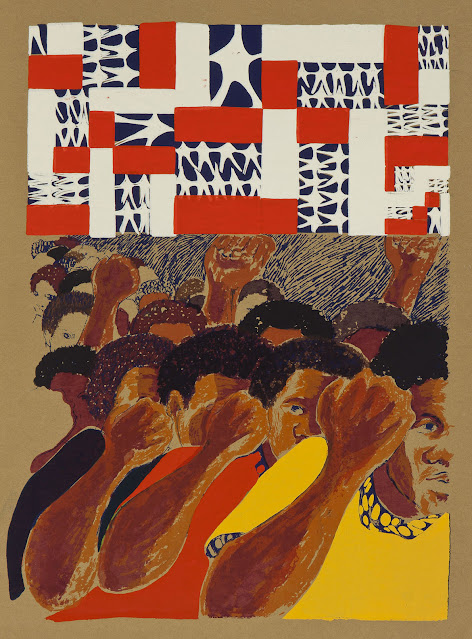David Paladin, (b. 1926, d. 1984)
“Mythmaker Stomping out Artist’s Sense of Reality”, 1975
The act of ignoring artwork produced by races, cultures or groups is not simply arrogance or a mistake. It is too often an attempt to deny or even eradicate.
The current heated U.S. political climate is an ideal time to continue the exploration of the artwork produced by people who are currently being targeted.
In the U.S., nearly 212,000 people have died from COVID - 19. Our government officials want us to only see numbers but behind each number was/is a person. In the U.S. people of color are at greater risk than others. Among the most vulnerable are Native Americans.
The Navajo Nation (the "Dineh" or "the People") people are located in the in the Southwest Cultural Region incorporating the lower parts of Utah and Colorado, all of Arizona and New Mexico, and the northern deserts of Mexico.
As early as 9500 BC. the first known inhabitants of the Southwest Region hunted mammoth and other game.
In 1864, "Kit" Carson and the United States federal government enacted a plan of ethnic cleansing and forced the relocation of the Navajo from their ancestral homelands to Fort Summer, a 40-square-mile reservation in eastern New Mexico. Years later the U.S.-Navajo Treaty of 1868 allowed the Navajo to return to only a small portion of their original homeland.
We might not all have known of the forced “Long Walk of the Navajo” but we are all very familiar with traditional Navajo rugs:
Navajo, 19th Century
c. 1885-1890
tapestry weave: wool, handspun and Germantown.
Today, the Navajo have suffered at least 10,500 cases of COVID – 19 and 560 known deaths. The essential protocols and lockdowns issued by President of the Navajo Nation, Jonathan Nez have done much to keep the virus in check. Unfortunately, the current administration has done very little to assist the Navajo.
The Navajo Nation, the largest of all U.S. Indian reservations, covers 27,413 sq. miles yet has only twelve Health Service facilities to serve over 350,000 citizens. The facilities had only 28 ventilators until finally receiving 50 from the U.S. (United States sent 200 ventilators to Russia as part of a $5.6 million humanitarian aid package, and it sent 50 ventilators to the Navajo Nation. https://www.usatoday.com/story/news/factcheck/2020/06/27/fact-check-us-sent-ventilators-navajo-despite-claims-otherwise/3265337001/
https://www.abc15.com/news/state/vital-resources-being-distributed-to-the-navajo-nation)
The Federal government may have changed its tactics since Kit Carson scorched the Navajo earth but they certainly do not appear supportive of the Navajo. By breaking treaty promises and ignoring the many issues initially created by the forced march the government has established an ideal landing place for COVID – 19.
About thirty percent of people do not have electricity. Poisoning of the water supply by US uranium mines has contributed to over thirty-six percent of the reservation residents lack of access to running water.
The reservation is a food desert, with only 13 grocery stores, which means some people travel up to 150 miles to shop.
More than a third of the people live without paved roads, cell phone service, landlines or safe housing.
Multiple Navajo generations often live together, this is cultural but it’s also due to chronic housing shortages, federal restrictions on construction, high unemployment and poverty on the reservation.
After weeks of waiting President of the Navajo Nation Jonathan Nez had to take the federal government to court to receive the money promised through The Cares Act.
We might not all have been familiar with the conditions on the Navajo reservation that have risen from the US federal governments long history of neglect and we might not all be familiar with recent efforts to destroy the lives of the Navajo, such as Trump’s “Curtis Bill” resolution which nullifies and shrinks former President Barack Obama’s December 2016 proclamation establishing Bears Ears as a 1.35 million-acre national monument in San Juan County, Utah. by 85 percent.
Athraigh Studio would like to help make you familiar with the art created by the people of the Navajo Nation, the "Dineh" or "the People" by presenting a small exhibition of current Navajo printmakers:
Melanie Yazzie
“He Died Before Coming Home” 1994
monotype
https://wheelwright.org/exhibitions/memory-weaving/
David Paladin, (b. 1926, d. 1984)
“Mythmaker Stomping out Artist’s Sense of Reality”, 1975
Litho
David Paladin, (b. 1926, d. 1984)
“Life, Dreaming Itself Into Being” 1975
Litho
Michael McCabe
Mono with Chin Cole’
For further information regarding COVID – 19 and the Navajo Nation:
https://navajotimes.com/coronavirus-updates/covid-19-across-the-navajo-nation/






























